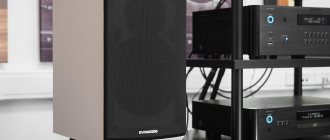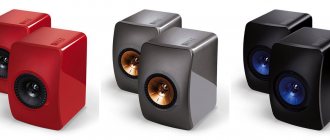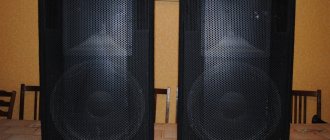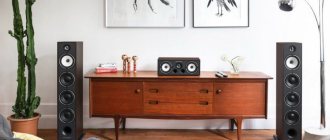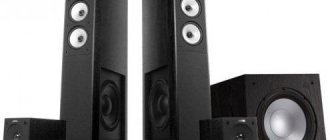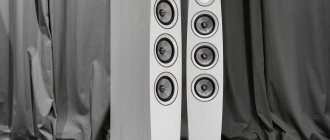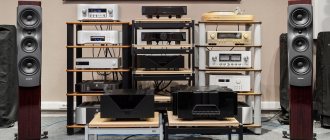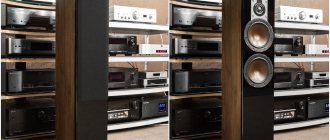Let's imagine a person who is interested in music, but has never paid attention to sound quality. And so, having heard a lot about Hi-Fi and High-End technology, he decides to check for himself what “real sound” is. As a rule, he doesn’t have much money, and it’s a pity to spend it on what he doesn’t yet know. Our test of bookshelf speakers will be very useful for just such a person, and it is in this price range that you can find speakers that can demonstrate true Hi-Fi sound quality. Yes, you will have to make a small allowance for the bass depth. But, on the other hand, bookshelf acoustics, as a rule, play better at low volumes than floor-standing ones, and it will be easier to place them in the room. A dozen speakers - plenty of choice. I am sure that among them there will be very, very worthy specimens.
Criteria for evaluation
We are dealing with classic workhorses, and the approach to testing is quite traditional. The frequency response and SOI will show us how flawlessly the speaker design is made from a technical point of view. Together with the design features of the model, this will constitute a design assessment. Listening will make its own adjustments and will reveal the sound character of the speakers. Good bass depth and high quality are rarely combined in the bookshelf format, so we won’t be too strict about this parameter. But having a clean and even upper register is quite possible for small speakers. The importance of this parameter is extremely important for the natural presentation of musical material. High-quality sound at low volumes is also important and is an indicator of smooth, almost linear speaker dynamics. Timbral fidelity will allow you to enjoy the full beauty of the sound of each individual instrument. After all, musical instruments are created in order to enjoy their sound, and not to try to understand what exactly is playing. All this will add up to a sound rating. The last assessment is inversely proportional to the price: higher the price - lower the assessment.
Acoustic Energy 301
Sound: 4 Construction: 4 Price: 4 Advantages: - High detail - Timbral fidelity Disadvantages: - Not enough air
When developing the 300 series, the designers achieved visual minimalism. All small details such as screws and grill mounts are excluded from the appearance. The front wall of the speaker is finished with a black rubber-like coating that matches the color of the driver diffusers. The finishing of the speakers is also minimalistic - black or white varnish. Model 301 houses a proprietary 28 mm fabric dome tweeter and a traditional, well-recognized midrange/bass driver with a cone made of bent, heavily anodized aluminum with a diameter of 110 mm. This speaker is a distant legacy of the legendary AE1 monitors.
Bookshelf acoustics Acoustic Energy 301
It is curious that the company decided to use a slotted bass reflex port located on the front panel. It was possible to save the size of the column while placing it conveniently near the wall.
Sound The absence of any noticeable sound color allows the speaker to unfold and, even when playing rather restrainedly, present musical compositions in an interesting way. The smallest details are clearly visible, and the timbres are very close to natural. The entire frequency scale is well balanced both in level and dynamics - the sound is holistic.
Upper register intelligibility is not bad, but it is a little lacking for an open sound with enough air. On complex compositions, the intelligibility of musical material decreases. At low volumes the sound character remains almost unchanged.
Measurements
The frequency response is very smooth. The decline in the low-frequency region is uniform. Bass is medium deep. The THD is quite low right down to the very bottom and is practically independent of the volume level. Impedance is unstable.
Connecting bookshelf speakers
To connect high-quality speakers to an amplifier, it is extremely important to use branded speaker cables. Moreover, the larger the core diameter, the better. Let us remember that the larger the core cross-section, the lower the cable resistance, and accordingly the quality of signal transmission is better. And the acoustic cable in the path, as mentioned earlier, is 30% of the sound. Hi-End bookshelf speakers support Bi-Wiring/Bi-Amping connections. Bi-Wiring connection involves connecting two cables per channel from one amplifier in such a way that the signal is supplied to the LF and MF/HF segments separately. Bi-Amping works on the same principle as Bi-Wiring with the only difference being that in this case a corresponding amplifier is used, each channel of which has separate outputs for the LF and MF/HF sections. Or, two independent amplifiers are used. Let us remind you that before connecting Bi-Wiring/Bi-Amping, the metal jumpers on the patch panel must be removed. The types of such switching can be clearly seen on the DALI Epicon 2 model.
conclusions
It should be noted that it is becoming less and less interesting to study the results of speaker measurements in our test laboratory. Almost all models showed a remarkably flat frequency response and a very low THD even in the bass region! This is explained by the fact that almost all companies have already adopted computer modeling tools, with the help of which you can make, perhaps, anything sound, which, for example, the company Boston Acoustics has proven to us more than once. Even the shape of the body no longer plays such a significant role; the main thing is to correctly calculate the damping elements. Therefore, the design ratings for all models are either good or excellent.
Two models from our test deserve special mention. These are MK Sound LCR 750 and Dynaudio DM 2/7. The companies that created them were initially focused on developing professional acoustics and pursue this line even in their youngest lines. The main principle is maximum accuracy in transmitting musical material. And no decorations. These two models fully meet this principle and, in fact, represent professional-level monitor acoustics, with all its advantages and disadvantages. Not all listeners may like the sound, or more precisely, the neutrality of the sound. This is a product for special music connoisseurs and connoisseurs, or even for a home studio. Both models are worthy of the sympathy prize.
Almost all companies have already adopted computer modeling tools, with the help of which you can make, perhaps, anything sound.
If we talk about beautiful and comfortable sound, then many of the speakers in our test successfully coped with this task. Accurate transmission of timbres, precise localization, accurate bass - all this is inherent in almost all speakers tested. The only difference is in the nature of the sound. And here the choice turned out to be rich: in the test you can find a dense, rich sound (PSB Imagine B), and an impressively sophisticated sound (Wharfedale Jade 3), and a collected, neat presentation of material (Canton Chrono 503.2), and an open airy image (Rega RS1, B&W 685), and even defiantly aggressive pressure (Martin Logan Motion 15). However, most of all I would like to highlight the French columns Triangle Color Bookshelf. They turn almost any musical material into a celebration of sound. The speakers know how to not miss the main idea of the work and at the same time present the material very beautifully, lively and dynamically. They are very pleasant and interesting to listen to. The Triangle Color Bookshelf model takes the title of test winner.
Which bookshelf speakers to choose for music?
Before purchasing speakers, you should set your budget in advance. It is clear that it is pointless to compare the quality of speakers for 10,000 rubles and speakers for 100,000-150,000. Determining the price category will reduce time by significantly narrowing the search range. When choosing, it is worth considering the level of other elements of the speaker system. It makes no sense to spend a large sum on high-quality speakers if the audio system itself was produced in an underground factory in China and bought for $10 on Aliexpress. After all, the speakers will only amplify and emphasize poor sound transmission, playing like used vinyl from the times of the USSR.
It is necessary to take into account the dimensions of the room where you plan to install the speaker system. The size and other features of the room can greatly limit your choice.
Having decided on the main indicators, you can choose a model. Our rating, compiled taking into account the price-quality ratio, technical characteristics and reviews of music lovers and professionals, will help with this.
Column stripes
The description of speaker models must indicate their type (configuration) - most often you will see 2- or 3-way designations. These terms mean how many bands (frequency ranges) the original signal received from the amplifier is divided into in the speakers. Therefore, often the number of column bars can be determined by the number of speakers on its front panel. However, there are possible nuances here. Since sometimes several speakers can be used to reproduce the low-frequency range in acoustics.
How many “bands” should a Hi-Fi acoustic have in order for its sound to be as accurate as possible?
Two, three or more
As always, first a little theory. Each speaker operates in a specific audio range. The reason for creating speakers with multiple drivers is that different physical sizes of drivers are needed to reproduce different frequencies.
For example, low frequencies require the movement of a significant volume of air at a relatively low speed. A speaker with a large diffuser (woofer) copes better with this task. On the other hand, high frequencies require very fast air movement, which a large speaker cannot provide. Therefore, the high-frequency speakers (known as tweeters) have a small moving membrane.
Triangle Esprit EZ Series Tweeter
A three-way speaker adds a speaker that reproduces midrange frequencies. Typically, the midrange driver is smaller than the woofer, but larger than the tweeter.
To ensure that each speaker in a multi-band speaker receives a signal of only its own frequency, crossover filters are used. We will talk more about these schemes in the next publication.
Two-way acoustics - pros and cons
There are several aspects that make two-way speakers the best choice for a home stereo system. First of all, it can be noted that they are more affordable than comparable three-way models in their class. This rule applies even if they have similar technical characteristics. The obvious explanation for this fact is that 2-way speakers have one less speaker.
Classic two-way acoustics Triangle Comete Ez
In addition, good three-way speakers are more difficult to develop, which also affects their cost. Also, two-way speakers are usually more compact than 3-way models. This makes it easier to place it in the room. Therefore, if these two factors listed above (purchase budget and availability of free space) are important to you, feel free to choose two-way speakers.
On the third lane
As we have already noted, in three-way acoustics there is a third speaker designed to reproduce mid frequencies.
Triangle Borea BR08 is an excellent example of modern 3-way acoustics
Such a specialized driver improves the sound of the speaker in the most audible range for humans - of course, if the speaker is designed correctly. Serious fans of acoustic recordings or vocals often choose three-way acoustics for their accurate reproduction of the sound of “live” instruments and voices. However, the advantages of three-way acoustics are not only this.
In two-way acoustics, both the tweeter and the low-frequency speaker (woofer) “capture” the mid-frequency range, which reduces the efficiency of their work. In three-way acoustics, these radiators are deprived of such additional load. As a result, the sound at high frequencies (HF) becomes more transparent, and at bass it becomes richer and more dynamic. This works even if both speakers have the same tweeters and woofers. And finally, three-way speakers usually require less power input from the amplifier to produce the same sound volume as two-way speakers. In other words, three-strips are harder to burn. This is worth taking note for those who like to listen to music loudly.
Three-way acoustics Triangle Australe EZ have three bass speakers at once
Which one is better?
It is difficult to say for sure which acoustics are better - two or three-way. As we can see, each of them has its own advantages, but there are also certain disadvantages.
Affordable and very high quality two-way speakers Triangle Borea BR03
Two-way speakers can be an excellent choice if your budget for purchasing speakers is limited. A three-way speaker, designed taking into account all the nuances, will cost significantly more, even if you choose from the same model range.
Still, if you are looking for the best speakers and are willing to spend a serious amount of money on them, we recommend that you pay attention to three-way speakers. For example, presented in the Borea or Esprit EZ series of the French company Triangle.
